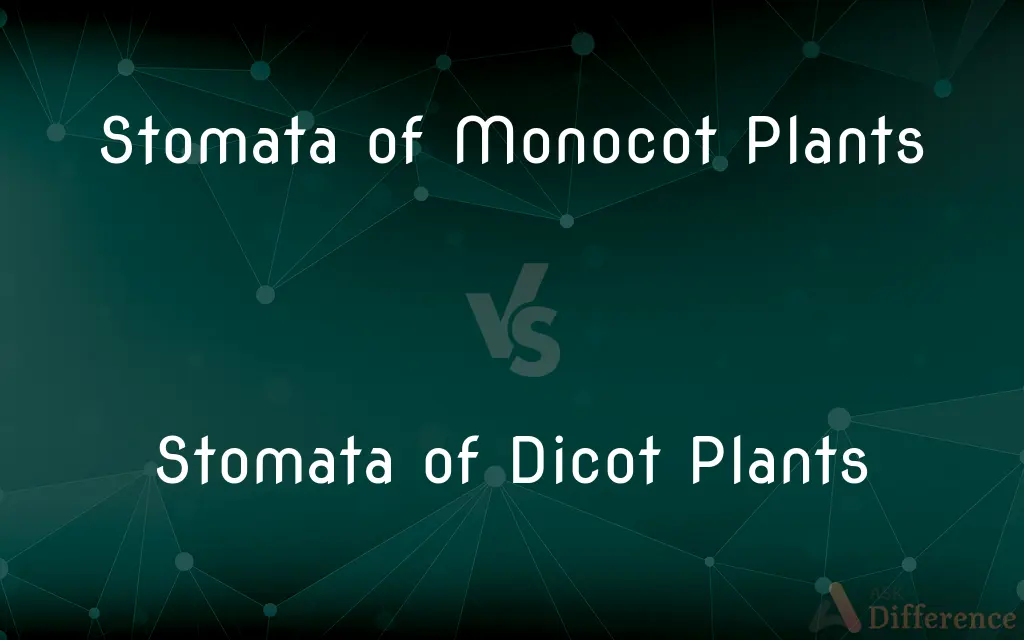Stomata of Monocot Plants vs. Stomata of Dicot Plants — What's the Difference?
By Tayyaba Rehman — Published on December 10, 2023
Monocot plants have stomata on both surfaces; dicot plants typically have stomata on the lower surface. Both are tiny pores for gas exchange.

Difference Between Stomata of Monocot Plants and Stomata of Dicot Plants
Table of Contents
ADVERTISEMENT
Key Differences
Stomata of Monocot Plants and Stomata of Dicot Plants are specialized structures in plants that allow for gas exchange, primarily the intake of carbon dioxide and the release of oxygen during photosynthesis.
Stomata of Monocot Plants are typically found on both the upper and lower surfaces of leaves. This arrangement ensures efficient gas exchange, given that monocots often grow closer to the ground, and exposure on both sides helps maximize their photosynthetic efficiency.
On the other hand, Stomata of Dicot Plants are predominantly found on the lower surface of leaves. This distribution helps in reducing water loss through transpiration, given that many dicot plants have broader leaves that are more exposed to environmental factors.
Both Stomata of Monocot Plants and Stomata of Dicot Plants play a pivotal role in the process of transpiration, which aids in nutrient uptake and provides a cooling effect. Despite their differences, the primary function of these stomata remains the same: facilitating the exchange of gases.
Comparison Chart
Leaf Surface Presence
Both upper and lower
Mostly lower
ADVERTISEMENT
Function
Gas exchange
Gas exchange
Adaptive Strategy
Maximize photosynthesis
Reduce water loss
Typical Plant Height
Closer to ground
Taller plants
Environmental Exposure
Both sides exposed
Lower side less exposed
Compare with Definitions
Stomata of Monocot Plants
Sites on monocot leaves where respiration occurs.
At night, stomata of monocot plants take in oxygen and release CO2.
Stomata of Dicot Plants
Sites on dicot leaves where respiration takes place.
Stomata of Dicot Plants open at night for the oxygen-carbon dioxide exchange.
Stomata of Monocot Plants
Tiny openings on both surfaces of monocot leaves allowing gas exchange.
The rice plant, a monocot, has stomata on both the upper and lower leaf surfaces.
Stomata of Dicot Plants
Tiny openings primarily on the lower surfaces of dicot leaves for gas exchange.
The rose bush, a dicot, has stomata mostly on its lower leaf surfaces.
Stomata of Monocot Plants
Structures in monocots facilitating photosynthesis by letting in CO2.
Stomata of Monocot Plants enhance their photosynthetic efficiency.
Stomata of Dicot Plants
Essential in controlling the internal atmosphere of dicots.
By regulating the stomata of dicot plants, the plant manages its internal humidity.
Stomata of Monocot Plants
Pores on monocots aiding in transpiration and nutrient uptake.
Through the stomata of monocot plants, water vapor exits, cooling the plant.
Stomata of Dicot Plants
Structures in dicots that help reduce excess water loss while admitting CO2.
The stomata of dicot plants have evolved to balance photosynthesis with water conservation.
Stomata of Monocot Plants
Essential for maintaining moisture balance in monocots.
Stomata of Monocot Plants adjust their opening to manage water loss.
Stomata of Dicot Plants
Pores on dicots contributing to transpiration and nutrient movement.
Through the stomata of dicot plants, water is released, helping in nutrient absorption.
Common Curiosities
How do Stomata of Dicot Plants conserve water?
By being primarily on the lower surface, they reduce water loss via transpiration.
What are the Stomata of Monocot Plants?
They are tiny pores on both surfaces of monocot leaves, facilitating gas exchange.
Why do Stomata of Monocot Plants appear on both surfaces?
This ensures efficient gas exchange since monocots often grow closer to the ground.
Do both Stomata of Monocot Plants and Stomata of Dicot Plants aid in photosynthesis?
Yes, they allow CO2 intake and O2 release, crucial for photosynthesis.
How do Stomata of Dicot Plants help taller plants?
By reducing water loss, they help manage the larger water needs of taller plants.
Are Stomata of Monocot Plants and Stomata of Dicot Plants essential for plant survival?
Yes, they are crucial for photosynthesis, respiration, and moisture balance.
How do Stomata of Dicot Plants and Stomata of Monocot Plants affect transpiration rates?
Monocots, with stomata on both sides, may have higher transpiration rates than dicots.
Are the sizes of Stomata of Monocot Plants different from Stomata of Dicot Plants?
Size can vary based on species, but function and presence depend on the plant type.
Do the Stomata of Dicot Plants and Stomata of Monocot Plants regulate their openings?
Yes, both adjust their opening sizes based on environmental conditions.
Where are the Stomata of Dicot Plants primarily located?
They are mostly on the lower surfaces of dicot leaves.
Are the functions of Stomata of Monocot Plants and Stomata of Dicot Plants different?
The primary function, gas exchange, is the same, but their placements and adaptations differ.
How do Stomata of Dicot Plants manage their water loss?
Their placement on the lower surface minimizes direct sun exposure, reducing transpiration.
Why do Stomata of Monocot Plants maximize photosynthesis?
Their presence on both leaf sides helps capture more light and CO2 for photosynthesis.
Why is understanding the differences between Stomata of Monocot Plants and Stomata of Dicot Plants important?
It helps in understanding plant adaptations, physiology, and environmental responses.
Can plants function without the Stomata of Monocot Plants or Stomata of Dicot Plants?
No, they are essential for gas exchange and plant survival.
Share Your Discovery

Previous Comparison
Cheeky vs. MischievousNext Comparison
RTV vs. SiliconeAuthor Spotlight
Written by
Tayyaba RehmanTayyaba Rehman is a distinguished writer, currently serving as a primary contributor to askdifference.com. As a researcher in semantics and etymology, Tayyaba's passion for the complexity of languages and their distinctions has found a perfect home on the platform. Tayyaba delves into the intricacies of language, distinguishing between commonly confused words and phrases, thereby providing clarity for readers worldwide.
















































